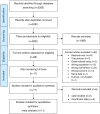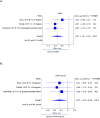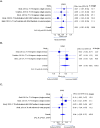Effects of neuromuscular gait modification strategies on indicators of knee joint load in people with medial knee osteoarthritis: A systematic review and meta-analysis
- PMID: 36129904
- PMCID: PMC9491578
- DOI: 10.1371/journal.pone.0274874
Effects of neuromuscular gait modification strategies on indicators of knee joint load in people with medial knee osteoarthritis: A systematic review and meta-analysis
Abstract
Objectives: This systematic review aimed to determine the effects of neuromuscular gait modification strategies on indicators of medial knee joint load in people with medial knee osteoarthritis.
Methods: Databases (Embase, MEDLINE, Cochrane Central, CINAHL and PubMed) were searched for studies of gait interventions aimed at reducing medial knee joint load indicators for adults with medial knee osteoarthritis. Studies evaluating gait aids or orthoses were excluded. Hedges' g effect sizes (ES) before and after gait retraining were estimated for inclusion in quality-adjusted meta-analysis models. Certainty of evidence was assessed using the Grading of Recommendations Assessment, Development and Evaluation (GRADE) approach.
Results: Seventeen studies (k = 17; n = 362) included two randomised placebo-controlled trials (RCT), four randomised cross-over trials, two case studies and nine cohort studies. The studies consisted of gait strategies of ipsilateral trunk lean (k = 4, n = 73), toe-out (k = 6, n = 104), toe-in (k = 5, n = 89), medial knee thrust (k = 3, n = 61), medial weight transfer at the foot (k = 1, n = 10), wider steps (k = 1, n = 15) and external knee adduction moment (KAM) biofeedback (k = 3, n = 84). Meta-analyses found that ipsilateral trunk lean reduced early stance peak KAM (KAM1, ES and 95%CI: -0.67, -1.01 to -0.33) with a dose-response effect and reduced KAM impulse (-0.37, -0.70 to -0.04) immediately after single-session training. Toe-out had no effect on KAM1 but reduced late stance peak KAM (KAM2; -0.42, -0.73 to -0.11) immediately post-training for single-session, 10 or 16-week interventions. Toe-in reduced KAM1 (-0.51, -0.81 to -0.20) and increased KAM2 (0.44, 0.04 to 0.85) immediately post-training for single-session to 6-week interventions. Visual, verbal and haptic feedback was used to train gait strategies. Certainty of evidence was very-low to low according to the GRADE approach.
Conclusion: Very-low to low certainty of evidence suggests that there is a potential that ipsilateral trunk lean, toe-out, and toe-in to be clinically helpful to reduce indicators of medial knee joint load. There is yet little evidence for interventions over several weeks.
Conflict of interest statement
There are no further conflicts of interest to disclose. All the competing interests are included. This does not alter our adherence to all PLOS ONE policies on sharing data and materials.
Figures




References
-
- Hunter DJ, Nicolson PJA, Little CB, Robbins SR, Wang X, Bennell KL. Developing strategic priorities in osteoarthritis research: Proceedings and recommendations arising from the 2017 Australian Osteoarthritis Summit. BMC Musculoskelet Disord. 2019;20(1):74. doi: 10.1186/s12891-019-2455-x - DOI - PMC - PubMed
-
- Hinman RS, Hunt MA, Simic M, Bennell KL. Exercise, Gait Retraining, Footwear and Insoles for Knee Osteoarthritis. Current Physical Medicine and Rehabilitation Reports. 2013;1(1):21–8.
Publication types
MeSH terms
LinkOut - more resources
Full Text Sources

